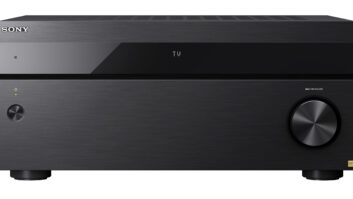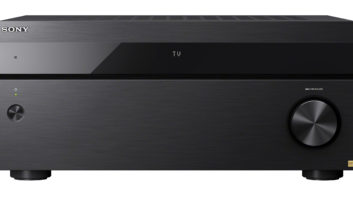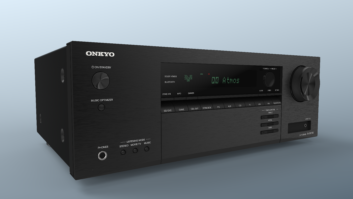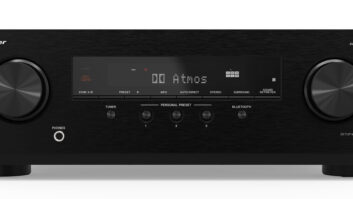
My first experience with NAD was back in the late ’90s when I was looking to purchase my first surround receiver. At the time, the salesperson explained that NAD products weren’t about bells and whistles but were about delivering terrific design with no-nonsense sound quality.
Cut to 2018, and we have the new T 777 V3, which sits atop the brand’s current line of AV surround receivers. While this features massive generational improvements over those models from 20 years ago, it remains steeped in much of the same design DNA philosophy, both visually and sonically.
With a matte-black steel finish, a few buttons, a volume knob, and ice-blue vacuum fluorescent display, its front panel has a clean and minimalist look. Compared to some modern designs that seem to have more buttons and knobs than an Enigma machine, this is actually refreshing and certainly less intimidating to the typical user.

Around back is where the T 777 V3 really differentiates itself. First you might notice there aren’t any analog video inputs–not one. No composite, no component, and hells-no S-Video. This receiver is for next-generation HDMI video devices only, so those old VCRs and LD players need not apply. There are plenty of analog audio inputs (six), including a 7.1 input. There are also analog audio pre-outs for all 11.2 channels should you wish to bypass the 777’s internal amplification, and outputs for Zone 2, 3, and 4.
A tad surprising for a flagship design is that the T 777 only features five rear HDMI inputs. (There is a front-panel HDMI input, though it is only HDMI 1.4/1080p.) While this might seem like plenty, my system actually maxed it out. Fortunately these are all full-bandwidth, 18Gbps HDMI 2.0a/HDCP 2.2 capable.
As a nod to custom integrators, the T 777 features RS-232 and Ethernet for integration with advanced control systems. It also includes both IR and 12-volt trigger inputs as well as three each IR and 12-volt outputs. Also included is a switched AC outlet. My only nit with the rear panel is that for such a quality product, the speaker binding posts feel a bit cheap and plastic.
One of the T 777’s best tricks is what NAD calls Modular Design Construction (MDC). Kind of like a computer, the rear panel of the T 777 is filled with cards that can be field removed and changed out as upgrades occur, allowing systems to stay current with new AV formats. This unit ships with NAD’s two latest cards, giving support to features like Dolby Atmos processing and Dirac Live room correction. You’ll notice that there is one empty slot on the back allowing for future expansion. MDC allows the T 777 to remain up to date and viable as a main system controller for years to come, and is really a massive differentiator of NAD over competing products.
Setup is mostly straightforward and is done either via the front-panel display or onscreen menu. Currently there is no way to configure the T 777 across the network. Configuration is pretty standard with the usual ability to rename and assign inputs, etc., but there are also some really notable other features. For example, the amplifier can be configured as either side surround, surround back, front biamp, front or rear height, or to drive Zone 2, 3, or 4. This is a ton of flexibility. You can also individually set the three triggers by zone or source, and each with an adjustable delay from 0-15 seconds. Further, you can select which speakers are active during Enhanced Stereo, NAD’s version of all-channel stereo.
My favorite setup feature, however, is the AV Presets. Here you can select up to five easily recallable presets that can store listening mode setup preference, DSP options, tone controls, speaker configuration, and even front-panel display. This is terrific if a customer wants to have their front speakers configured as large when listening to two-channel, but small when watching movies. Or perhaps another preset to bump the gains on the subwoofers and height speakers.
Two other big features of the T 777 are the inclusion of DIRAC’s highly regarded Live room correction and BluOS for streaming music. DIRAC is performed by connecting a computer (PC or Mac) to the network and then running a series of nine measurements. You can load up to four separate measurement filters into the T 777 and easily recall them (including via the presets function mentioned above). The T 777 includes a limited version of the DIRAC software that limits frequency adjustment from 20-500Hz, with the full software version available for $99.
The T 777 offers everything there is to love about Bluesound and can function as an audio zone in a full Bluesound system. Notably, BluOS handles full high-resolution (24-bit/192kHz) streaming, decodes MQA (Master Quality Authenticated) audio files, and can serve as an endpoint for the terrific Roon audio system.
Definitely don’t let NAD’s highly conservative “Full Disclosure Power” rating of 80 watts per channel concern you; the T 777 effortlessly produced cinematic volume levels in my large listening space without any strain or distortion. I’d describe the sound quality as full, detailed, and rich, leaning slightly toward warm, but in a definitely pleasing way. Listening to music on the T 777 was always a treat.
The T 777 keeps with NAD’s philosophy of delivering high-performance sound while discarding unnecessary bells and whistles that get in the way of that goal. The only added DSP audio modes beyond Dolby and DTS are NAD’s exclusive EARS, designed to deliver “subtle but highly natural and believable ambience from nearly all ‘natural acoustic’ stereo recordings,” and Enhanced Stereo.
I watched hours of TV and movie content with the T 777 in my system, and it always did an admirable job conveying the onscreen action while delivering solid, intelligible dialog, and tight resolved bass thanks to DIRAC. The one thing I noticed compared to my reference processor (a Marantz AV8802A) is that the T 777 was far more restrained in its use of Dolby surround upmixing. With the T 777, I almost never noticed any overhead content, even when standing on a chair with my ear to the ceiling speakers.
The T 777 isn’t without its quirks. For one, DTS:X isn’t yet supported, nor is any kind of DTS upmixing (Neural:X). This is expected to come via a firmware update this summer. The NAD Remote mobile app crashes every time you open it, making it unusable. Again, this is expected to be resolved via an update. I could never get ARC to work with my Sony TV; the receiver’s HDMI and Digital lights just blinked continually and audio never comes through. Obviously, performance with other TVs will vary, but Sony is a pretty big brand to have an issue with. Finally, the secondary HDMI’s output being limited to 1080p will mean the T 777 really isn’t the right match for systems that use dual displays.
At $2,499 MSRP, the NAD T 777 V3 sits at the premium range of AV receivers, especially those with only seven channels of amplification on board. However, that money gets you terrific build quality and a ton of sonic performance, some incredible upgrade possibilities via NAD’s MDC, and fantastic wireless music streaming courtesy BluOS. For customers that value quality, sonics, and performance, the T 777 V3 more than delivers.







